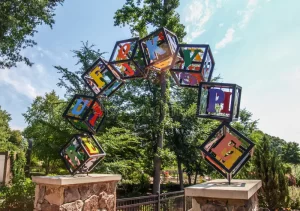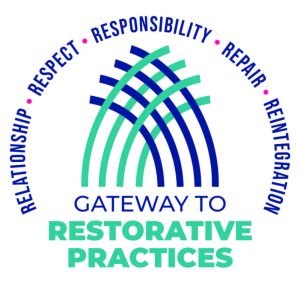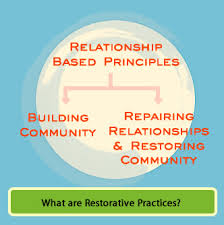The end of the 2022-23 school year aligns with a decade of adventure as a part-time Restorative Practices in Schools trainer and consultant with a large school district. Over the years my webpage From Diapers to Diamonds offered a dedicated page for Restorative Practices in Schools participants to access. As the need grew, I realized I needed an entire webpage devoted to restorative practices.
Original Plans Change
The original plans were to revise my current webpage until I discovered it is less expensive to create a new one. Kim Eddy, WordPress designer and programmer does work for my husband, Rick, so he suggested I contact her. I began working alongside her on the new page and with pages and pages of ideas all stored in a file folder filled with ideas and pictures in anticipation of this day, Kim had quite the task before her.
The Adventure Begins
The pathway to a new webpage is an adventure. After spending hours locating restorative practices/justice webpages already out there, I decided my webpage would be Restorative Practices in Schools for Educators. The purpose and who the webpage is for is clear. But I’m uncomfortable with it. It seems too long and too boring. While Rick and I are in Palm Desert in August 2023, I ask Rick to pray with me about discovering a different webpage name.
The Sign Awaits
The next day I’m driving to a shopping center I’ve driven to countless times. But as I turn onto the road, I’m suddenly curious. I wonder, What’s the name of this shopping center? I strain to read the upcoming sign. It says Gateway. Immediately I thought, That’s it. Gateway to Restorative Practices. From that moment I moved forward with the Gateway concept.
Next, I begin scouring the Internet for gateway ideas for my logo. Any potential gate image I find I save to my logo folder. I really like the image below with the blocks on the pillars. The blocks will spell G-A-T-E-W-A-Y.

This image is the gateway-gardens-greensboro-north-carolina-work-progress-includes-fun-children-s-garden from https://www.dreamstime.com/stock-photos
How Many Pillars Are Out There?
I find every type of pillar imaginable. Pillars are too fancy, too plain, too detailed, and so on. Maybe half a pillar will work better than a full one. I considered other images, but I like the block concept on a half pillar enough that I send ideas to Kim to create potential logos. I’m happy with what she designs and am ready to move forward but decide some input from others would be advisable for this project.
Input From Others
I send the gateway blocks with pillar images to a group of friends and family for input. A few like some of them but most say the blocks look too childish and the various pillars/columns don’t look right. I get suggestions that the logo needs to look more like a gate or entrance. I’m tempted to use the one I like but wisdom wins, and I adhere to the input from others.
Archways and Gateways
More image searching. This time I’m intently looking for various arches, gates,  and entrances. I view over 40 architectural archway styles. I discover countless entrances that use archways, mostly to gardens or educational institutions. I narrow my choices to a circular image and one with archway lines. Here’s the circular image I like. [Gateway to College]
and entrances. I view over 40 architectural archway styles. I discover countless entrances that use archways, mostly to gardens or educational institutions. I narrow my choices to a circular image and one with archway lines. Here’s the circular image I like. [Gateway to College]
Kim creates more logos. I send the archway and circle logos out for preview. This time there’s more consensus. I feel some relief. I’m getting closer to the logo finish line.
Colors Abound
Now it’s time to select the color theme. Kim sends me examples of color schemes. I choose a few I like, but I’m not sold on them. Too bright. Too dull. Too gold. Too yellow-green. Kim mentions I can select colors from various schemes and combine them. I consider that while I come across 2022 and 2023 popular color schemes and narrow my choices to 3 or 4. Ultimately, I still can’t decide. Again, I pray. “Lord, please help me choose the color scheme.”
Color Scheme Awaits
A few days later I walked into my doctor’s office and the colors on the wall await. Immediately I thought, these are the colors for my web page. I’ll add hot pink as the 10% color accent. I took a photo of the wall. I left the office two hours later with no help for my pain, but the colors for my logo are decided.
I’m excited driving home. Some people may consider it silly to pray about little things like webpage names and colors. I’m always amazed at how God answer prayers, but He’s also concerned about the little things when I petition Him. Here’s the wall and colors from my doctor’s office. [Boomerang] 
Kim easily identifies the specific colors. The 5 R’s of Restorative Practices actually represent the restorative process from start to finish: Relationship, Respect, Responsibility, Repair, and Reintegration. They are simple and clear; I really want the 5 R’s in my logo.
Sneak Peak
Ultimately, Kim combines the archway lines with the 5 R’s in a circle to offer a second logo for my endeavors. Here’s a sneak preview of the logos for my new webpage that is near completion.
 A Special Thank You
A Special Thank You
I especially want to thank those who took the time to offer their input and guidance. Thank you to my faithful writers group: Pauline, John, and Pam, my husband Rick, my friend Barbara, and my daughter Michelle who used her graphic design background to direct me along the way. I also want to thank my nephew, Fred, for showing me various web page styles and features. I’m also grateful for Kim who is creative and patient with me.
Introducing Gateway to Restorative Practices
I can’t wait to introduce you to my new webpage, Gateway to  Restorative Practices, and all it offers that I was unable to include on one designated page on my original webpage, From Diapers to Diamonds. I will keep you updated when it is ready. You’re going to appreciate all it offers.
Restorative Practices, and all it offers that I was unable to include on one designated page on my original webpage, From Diapers to Diamonds. I will keep you updated when it is ready. You’re going to appreciate all it offers.

 Many of you know that I’ve been working on creating a curriculum for an all-day new seminar for quite some time. RP 201 From ACEs to PACEs – Building Restorative Relationships launched on October 21, 2023. Some activities went exactly as planned while others need some improvement. I used more quotes than usual in this seminar because they helped introduce trauma and restorative practices principles. In this blog post I will share some of my favorites.
Many of you know that I’ve been working on creating a curriculum for an all-day new seminar for quite some time. RP 201 From ACEs to PACEs – Building Restorative Relationships launched on October 21, 2023. Some activities went exactly as planned while others need some improvement. I used more quotes than usual in this seminar because they helped introduce trauma and restorative practices principles. In this blog post I will share some of my favorites. just discovering they have ACEs indicators, they need more than just a score. Donna Jackson Nakazawa is the author of Childhood Disrupted:
just discovering they have ACEs indicators, they need more than just a score. Donna Jackson Nakazawa is the author of Childhood Disrupted: 

 It feels a little strange to write a reflection about recent events, but it will finish the reflections for the 2022-2023 school year. In December I learned that we would be training the District’s newly hired behavior analysts in January. This kept me busy developing tier 3 strategies for them.
It feels a little strange to write a reflection about recent events, but it will finish the reflections for the 2022-2023 school year. In December I learned that we would be training the District’s newly hired behavior analysts in January. This kept me busy developing tier 3 strategies for them.



 As the circle keeper, I’m concerned about such a dark answer. I wonder, what happened today? What’s going on? What’s behind the answer? How can I support this person?
As the circle keeper, I’m concerned about such a dark answer. I wonder, what happened today? What’s going on? What’s behind the answer? How can I support this person?